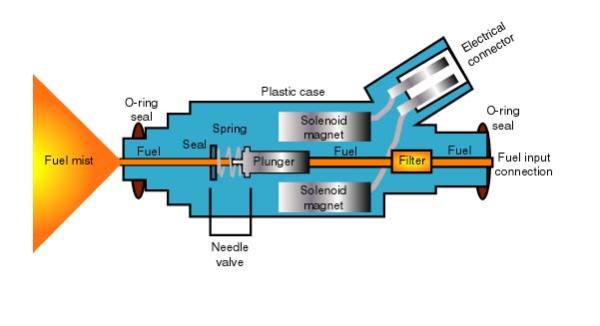Fuel Injection
Like the carburetor, electronic fuel injection delivers a mist of
fuel into the incoming air entering the cylinder. However it
isn’t done using vacuum, its done by high pressure injection,
controlled by a computer.
Put simply, fuel injection replaces the carburetor’s fuel bowl
and metering jets with electronically controlled high pressure
nozzles that atomize fuel instantly, without the need for
engine vacuum. Fuel injectors work like the nozzle of a
spray bottle. First fuel is pumped into each fuel injector
under high pressure. Then an electronic signal is sent from a
computer to the injector telling it to spray. The tip of the
fuel injector has a tiny needle valve. When the electrical
signal reaches the injector the needle valve opens forcing the
high pressure fuel through a tiny hole-exiting as a misty
spray-perfect for combustion. The key to getting a proper
misty spray is high fuel pressure.
Fuel injection pumps fuel from the gas tank to the engine,
just like a carburetor. The difference is that fuel injection
requires the fuel to be delivered at a much higher pressure.
Carburetors can run at less than 10 psi, fuel injection
systems require at least 10 psi sometimes more than 20-30
psi. This is accomplished by a more powerful electronic fuel
pump, in or near the gas tank that pushes the fuel towards
the engine. When the fuel reaches the engine it passes
through a fuel pressure regulator, which limits ongoing fuel
pressure to a set figure. Excess fuel is then returned to the
gas tank by a return fuel line. This way only the fuel needed
to reach necessary pressure passes through the regulator and
the rest returns to the tank, stays cool and await another trip
through the pump.
There are several benefits of Fuel Injection over the
carburetor: First and foremost- fuel injection is controlled by
a computer and therefore almost infinitely adjustable for any
environmental conditions or purpose. For example, when the
temperature changes, the density of air changes as well.
When it’s colder the air is more dense-therefore more air
enters the engine, requiring more gasoline to be injected. A
fuel injection computer can make this adjustment. The
computer can measure the airflow into the engine through a
sensor (typically called the mass airflow sensor). Then the
computer adjusts the amount of fuel to match the airflow.
To review the way the fuel flow is adjusted, the computer
changes the time that the fuel injector is opened- longer for
more fuel, shorter for less.
Like the carburetor, electronic fuel injection delivers a mist of
fuel into the incoming air entering the cylinder. However it
isn’t done using vacuum, its done by high pressure injection,
controlled by a computer.
Put simply, fuel injection replaces the carburetor’s fuel bowl
and metering jets with electronically controlled high pressure
nozzles that atomize fuel instantly, without the need for
engine vacuum. Fuel injectors work like the nozzle of a
spray bottle. First fuel is pumped into each fuel injector
under high pressure. Then an electronic signal is sent from a
computer to the injector telling it to spray. The tip of the
fuel injector has a tiny needle valve. When the electrical
signal reaches the injector the needle valve opens forcing the
high pressure fuel through a tiny hole-exiting as a misty
spray-perfect for combustion. The key to getting a proper
misty spray is high fuel pressure.
Fuel injection pumps fuel from the gas tank to the engine,
just like a carburetor. The difference is that fuel injection
requires the fuel to be delivered at a much higher pressure.
Carburetors can run at less than 10 psi, fuel injection
systems require at least 10 psi sometimes more than 20-30
psi. This is accomplished by a more powerful electronic fuel
pump, in or near the gas tank that pushes the fuel towards
the engine. When the fuel reaches the engine it passes
through a fuel pressure regulator, which limits ongoing fuel
pressure to a set figure. Excess fuel is then returned to the
gas tank by a return fuel line. This way only the fuel needed
to reach necessary pressure passes through the regulator and
the rest returns to the tank, stays cool and await another trip
through the pump.
There are several benefits of Fuel Injection over the
carburetor: First and foremost- fuel injection is controlled by
a computer and therefore almost infinitely adjustable for any
environmental conditions or purpose. For example, when the
temperature changes, the density of air changes as well.
When it’s colder the air is more dense-therefore more air
enters the engine, requiring more gasoline to be injected. A
fuel injection computer can make this adjustment. The
computer can measure the airflow into the engine through a
sensor (typically called the mass airflow sensor). Then the
computer adjusts the amount of fuel to match the airflow.
To review the way the fuel flow is adjusted, the computer
changes the time that the fuel injector is opened- longer for
more fuel, shorter for less.

Fuel injector diagram
Fuel injection system diagram


